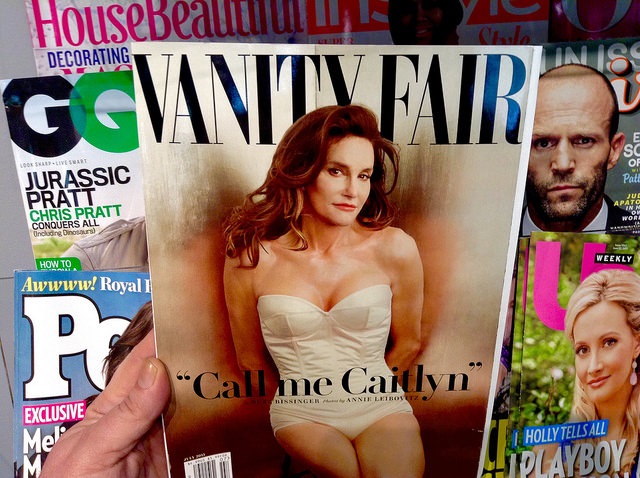During the 2015 NUS Women’s Conference, I was passed a note from a friend. “I’m so happy and proud that you are here,” it read, “All my love, sister.” I was surprised at my reaction to the word “sister,” which made me feel an unfamiliar sense of warmth and community.
Many trans* women at the conference made clear that they found “sibling” to be more inclusive than sister. Still, I was deeply and unexpectedly touched by the note. It shouldn’t rationally matter if I’m called “sister” or not. However, I could feel the difference when it actually happened. My gender was being expressed in a manner satisfactory to me, and recognized as such by someone I care about.
I’ve thought about the experience numerous times in reaction to articles I’ve read on the complications of Caitlyn Jenner’s trans* female identity. “Sister” is a linguistically constructed concept, and yet, that didn’t make it feel any less real.
Elinor Burkett has written in the New York Times that much of trans* activism has “undermined almost a century of hard-fought arguments that the very definition of a female is a social construct that has subordinated us.” Burkett argues that trans* women “stake their claim to dignity as transgender people by trampling on [hers] as a woman,” which is a position that I’ve heard more than once.
Reading the piece was challenging, because it forced me to come to terms with the fact that my own claims to womanhood and femininity are probably unconvincing to many people (apart from those who are familiar with drag queen subculture, and the phrase “Charisma, Uniqueness, Nerve, and Talent”.)
Despite that disappointment, I found the existential challenge rewarding, but was taken aback by the fact that although Burkett is correct on some points, her expectations of Jenner are completely unrealistic, and clearly born from instinctive defensiveness.
First, where I agree. Like Burkett, I often have difficulty with women like Jenner because I find their language problematic. I also don’t find it particularly empowering to see Jenner present herself as “a tidy box, reduced to hoary stereotypes.” I have been most critical of the impulse to tell Jenner that she is ‘beautiful.’ This is welcome, and necessary, given that many trans* women are trained to believe that they aren’t sexually desirable.
At the same time, aesthetics have their own binary, and beauty cannot exist without ugliness. I find it strategically dangerous to rely too heavily on being considered ‘beautiful.’ It provides some of us with acceptance and assimilation at the same time that it intensifies the marginalization of others.

However, unlike Burkett, I don’t understand the problem as being that trans* women are “people who haven’t lived their whole lives as women” are redefining femininity based on notions of womanhood gleaned from mass culture. Rather, it is obvious that when Jenner told Diane Sawyer, “my brain is much more female than it is male,” she was sacrificing analytical precision and socially responsible language in order to ‘pass.’
There are political consequences to that move. Burkett is correct for noting that Jenner’s comments are actually quite regressive, but we have to be clear about the problem. It’s with the fact that trans* women like Jenner are forced to adapt, which Burkett doesn’t notice out of her own identitarian defensiveness.
Burkett reads that Sawyer quote as Jenner “buying into the notion that minor differences in male and female brains lead to major forks in the road and that some sort of gendered destiny is encoded in us.” When I saw the interview, I read it differently.
Sure, the brains quote is “the kind of nonsense that was used to repress women for centuries,” and Jenner clearly didn’t phrase herself properly. However, why does Burkett not see that Sawyer was in the wrong for expecting Jenner to answer a completely unfair question? Jenner was told to answer a varation of, “How do you know you’re a woman? When did you know that?”
She’s not the first trans* woman, and indeed gender nonconforming person in general, to be placed in that situation. It’s almost impossible for anyone to give a sophisticated answer, especially in a widely-publicized interview where Jenner is being expected to speak accessibly. She sacrificed responsible language, and subtlety, for an answer that Sawyer and her viewers would more dependably accept.
I’m not about to fault her for wanting to pass. Trans* people in general suffer far higher rates of substance abuse, homelessness, unemployment, hate crimes, and suicide than the general population. It is also fairly likely that if she didn’t carefully seek to pass, Caitlyn Jenner would still be referred to as Bruce.
That is the harsh reality of what it means to be a trans* woman. We shouldn’t forget that it was only a generation ago that one of Christine Jorgensen‘s fiancees were fired for being romantically connected to her. I’m highly critical of Jenner, but I understand why she said what she said.
Shortly after reading Burkett’s article, I pulled out a sheet of blank paper, and wrote “How do I know I’m really a woman?” at the top. It was a thought experiment to see if I could sufficiently justify my womanhood, brought on by the fact that she unintentionally anticipates the media frenzy about Rachel Dolezal.
“Imagine the reaction,” she writes snarkily, “if a young white man suddenly declared that he was trapped in the wrong body and, after using chemicals to change his skin pigmentation and crocheting his hair into twists, expected to be embraced by the black community.”
Her point is that she shouldn’t be forced to accept the cartoonish Jenner as a ‘legitimate woman.’ After all, she “came out as a sex bomb” and constitutes a walking feminine stereotype who seems to be sporting womanhood like it’s minstrel blackface. I’ve heard variations on these arguments before, and it isn’t surprising that they’ve come out again with Jenner.
Adolph Reed, Jr. tackles the comparison most compellingly in CommonDreams, benefiting from a real-world example in the Dolezal fracas. “The claim that Dolezal’s identity is false and transgendered people’s are true immediately provokes a ‘Who says,'” Reed argues. “There is no coherent, principled defense of the stance that transgender identity is legitimate but transracial is not, at least not one that would satisfy basic rules of argument.”

If that is the case, then how do I know that I’m a woman, especially given that I’m a person of colour who was deeply affected by Dolezal’s conduct? It wasn’t long before I realized that while scribbling justifications for myself, I was missing the entire point. In fact, I was behaving as though Sawyer was asking me the same question that she placed before Jenner. Why should I have to use the “rules of argument” to justify myself to either Burkett, or more reasonably Reed?
The rules sensibly require that I firmly link myself to a fixed identity in order to gain wider recognition, when everything about my sexuality compels me to argue that transitioning is only possible when you admit that identity doesn’t have essential boundaries. Rather, it can be subjectively contested, and is constantly open for debate. It could very well be that Dolezal is a trailblazer in the same way as Jorgensen.
The real question is which, and how much, resistance is occurring when the transitioning subject pushes back against objective definitions of how they should identify. Burkett overlooks this factor, and Reed only hints at it when he correctly points out that the only limit for women like Dolezal and Jenner is how much the rest of us will accept. It reflects one of the core tensions in identity politics, which is how the self-identifying subject is treated based on legitimate images of certain identities that are themselves arbitrary social constructs.
As far as my own womanhood, it reflects an exercise in radical subjectivity that I share with Jenner, with all her flaws. When either of us claim to be women, we’re boldly taking ownership of our sexual anatomy, gender identity, and sexuality in such a manner that society is forced to recognize our terms, rather than the other way around.
It is a massive rebuke to objective attempts to police our bodies, whether through state violence or social expectation, and it must be recognized that fully understanding trans* identities means applying their fluidity to a political stance against non-consensual identity, be it gendered or not. That is why it is such an important feminist position.
I found it most upsetting to read that Burkett is clearly threatened by women like me when she writes, “Their truth is not my truth. Their female identities are not my female identity.” Her defensiveness seems to be born of a reaction to Jenner’s mere existence, and yet, at no point does Jenner say that her female identity is anyone else’s female identity.
Neither does she argue that her truth is someone else’s truth. “Truth” is a completely subjective concept, and ultimately, Jenner’s sexual anatomy, gender identity, and sexuality has as little to do with me as it does with Burkett. The actual problem seems to be with how Jenner expresses herself, and there are debates to be had on that point, especially as trans* women like her do hit the mainstream.
However, it is important to remember that certain behaviour patterns are not inherently problematic, and they need to be judged in context. Ironically, Jenner is experiencing the same criticism of ‘propagating cartoonish archetypes of femininity’ as the working-class women from urban America who are dismissed as “ratchets” or “chongas” for expressing themselves in flamboyant terms that their peers read as obscene. Burkett doesn’t sufficiently consider that Jenner may honestly be exercising her own agency in presenting herself the way she does, and that her ability to do it rests on the legacy of prior generations of feminist debate, activism, and scholarship.
It is useful to conclude by referring to the way that Marx discusses religion in A Critique of Hegel’s Philosophy of Right (1844). Marx writes that “criticism has plucked the imaginary flowers on the chain not in order that man shall continue to bear that chain without fantasy or consolation, but so that he shall throw off the chain and pluck the living flower.”
The point wasn’t to exterminate religion. It was to disassemble illusions, so that actual happiness could be obtained through independent decision-making, rather than imposed mythologies. The question is whether Jenner is doing that, and how she interacts with social structures that affect the agency of other women, including those who identify as trans*. Is she emulating cartoonish femininity? Or does her radical subjectivity represent Marx’s ideal of “throwing off the chain and plucking the living flower”?
This topic is complicated enough that it could be both, but if there really is such a thing as a “trans* ally,” then it is their responsibility to affirm the bravery of someone doing the latter. As for me, I still have that note where I’m called “sister.” Maybe the word “sister” is a chain for other people, but I prefer to think of it otherwise. My friend gave me a taste of the living flower.
Photographs courtesy of Mike Mozart, irina slutsky, and Shaun Metcalfe. Published under a Creative Commons License.





